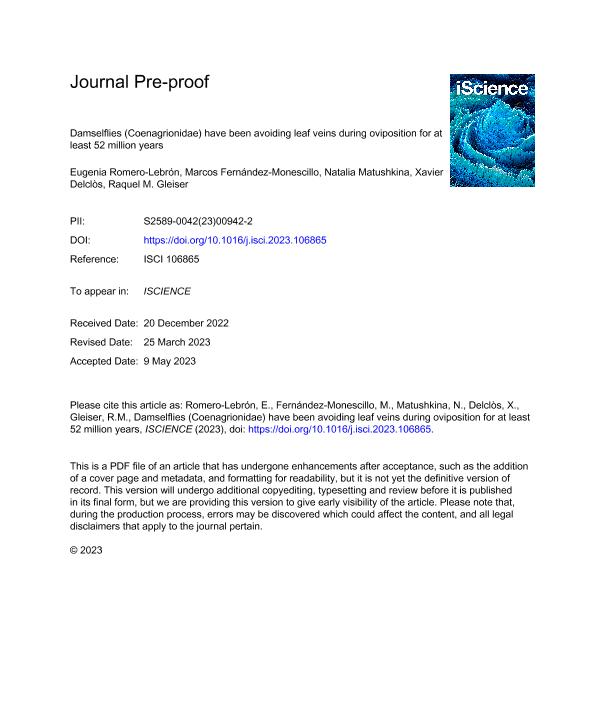Artículo
Damselflies (Coenagrionidae) have been avoiding leaf veins during oviposition for at least 52 million years
Romero Lebrón, María Eugenia ; Fernández García, Marcos
; Fernández García, Marcos ; Matushkina, Natalia; Delclos Martinez, Xavier; Gleiser, Raquel M.
; Matushkina, Natalia; Delclos Martinez, Xavier; Gleiser, Raquel M.
 ; Fernández García, Marcos
; Fernández García, Marcos ; Matushkina, Natalia; Delclos Martinez, Xavier; Gleiser, Raquel M.
; Matushkina, Natalia; Delclos Martinez, Xavier; Gleiser, Raquel M.
Fecha de publicación:
16/06/2023
Editorial:
Elsevier Inc.
Revista:
iScience
ISSN:
2589-0042
Idioma:
Inglés
Tipo de recurso:
Artículo publicado
Clasificación temática:
Resumen
Plant-insect interactions can provide extremely valuable information for reconstructing the oviposition behavior. We have studied about 1350 endophytic egg traces of coenagrionid damselflies (Odonata: Zygoptera) from the Eocene, identifying triangular or drop-shaped scars associated with them. This study aims to determine the origin of these scars. Our behavioral study of about 1,800 endophytic eggs from recent coenagrionids indicates that these scars were caused by ovipositor incisions, but without egg insertion. The scar correlates (χ2-test) with leaf veins in both fossil and extant species. We infer that a female would detect the proximity of a leaf vein and avoid egg-laying, generating a scar that also fossilizes. For the first time, a scar produced by the ovipositor has been identified, indicating the existence of undesirable areas for oviposition. Accordingly, we recognize that Coenagrionidae damselflies (narrow-winged damselflies or pond damselflies) have been avoiding leaf veins for at least 52 million years.
Palabras clave:
ENTOMOLOGY
,
EVOLUTIONARY BIOLOGY
,
PALEOBIOLOGY
Archivos asociados
Licencia
Identificadores
Colecciones
Articulos(CCT - CORDOBA)
Articulos de CTRO.CIENTIFICO TECNOL.CONICET - CORDOBA
Articulos de CTRO.CIENTIFICO TECNOL.CONICET - CORDOBA
Articulos(IMBIV)
Articulos de INST.MULTIDISCIPL.DE BIOLOGIA VEGETAL (P)
Articulos de INST.MULTIDISCIPL.DE BIOLOGIA VEGETAL (P)
Citación
Romero Lebrón, María Eugenia; Fernández García, Marcos; Matushkina, Natalia; Delclos Martinez, Xavier; Gleiser, Raquel M.; Damselflies (Coenagrionidae) have been avoiding leaf veins during oviposition for at least 52 million years; Elsevier Inc.; iScience; 26; 6; 16-6-2023; 1-23
Compartir
Altmétricas



